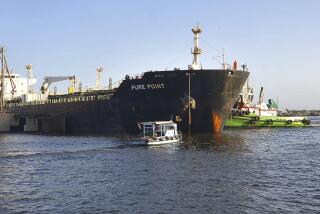Russia Is World’s Key to Having Oil to Burn
- Share via
With sky-high gasoline prices burning into family budgets, the oil-using world listened anxiously last week for words of deliverance from the Saudi Arabian oil minister, Ali Ibrahim Naimi. Folks would have been wiser to listen to Russian President Vladimir V. Putin.
For as significant as Saudi production is -- and as helpful as Naimi’s pledge to increase petroleum output by 11% to 9 million barrels a day should be -- it is Russia that will lift the globe out of its current energy funk.
In the last five years, Russia’s oil production has soared 48%, thanks to steadily rising flows from new wells. The country is already producing 9 million barrels of oil a day, making it the world’s largest producer.
But it isn’t about to stop there. Putin and his oil ministers plan to crank up output to 11 million barrels a day in the next five years. That rise, coupled with the efforts of several other suppliers, is why crude prices -- now at a lofty $40 a barrel and in some eyes headed to a stratospheric $50 -- will settle back down to $25 by 2006.
It may sound crazy as American motorists head into the summer driving season confronted by record pump prices. But by 2010, even as developing countries such as China and India exhibit a nearly insatiable demand for energy, production from non-OPEC nations probably will generate a surfeit of oil. Today’s headlines -- and hand-wringing -- will be a distant memory.
Joseph Stanislaw, president of Cambridge Energy Research Associates, is among those who see an oil surplus ahead. He predicts that global production, now at 82 million barrels a day, will grow by 20 million barrels by decade’s end.
“Key to this balance is Russia,” says Stanislaw, who has just issued a report titled “Oil: How High Can It Go, and for How Long?”
New fields in Siberia are being developed by companies that suddenly stand among the biggest anywhere. Lukoil Oil Co., Russia’s largest petroleum firm, for example, is now the world’s second-largest private holder of oil reserves, after Exxon Mobil Corp. (Lukoil also has acquired more than 2,000 gas stations in the U.S.)
Yukos Oil Co. and Sibneft, Russia’s second- and third-ranked producers, respectively, are also developing projects in Siberia’s forbidding vastness.
Russia sets aside opportunities in Siberia for homegrown companies, but it takes in partners elsewhere in its enormous territory. ConocoPhillips, for example, is in a joint venture in the Russian Arctic with Rosneft (“neft” is the Russian word for oil). And Exxon Mobil is part of a project on Sakhalin Island in the Russian Far East.
As is always the case with finding and tapping oil, collecting the prize isn’t easy. For all its ambitions, Russia faces a paucity of pipeline capacity as it tries to get the stuff out of Siberia to waiting markets in Europe and Asia. Putin, in fact, stepped in personally last week to reprimand Transneft, the state-controlled firm with a monopoly on pipelines, for bureaucratic dawdling.
He made specific suggestions for pipelines that would run from eastern Siberia to the Black Sea. Putin also is pushing Yukos to pump 1 million barrels a day from its new Siberian field, even though he put Yukos’ chairman, Mikhail Khodorkovsky, in jail in December.
“The government must base its decisions on the interests of the state as a whole and not on those of individual companies,” the former KGB member said in a speech Wednesday.
Russia is not alone in adding to the world’s supply of oil. Other countries including Mexico, Nigeria and Libya came forward last week with vows to expand their output as well.
For its part, Canada plans to raise its production by 78% (to about 5 million barrels a day) this decade, mainly by increasing output from the Athabasca oil sands in northern Alberta. The sands are gigantic formations that hold more than 1.6 trillion barrels of oil -- more than all the world’s present reserves.
Companies don’t actually drill the oil sands. Instead, they mine the muck and manufacture crude oil from a mixture of sand, water and bitumen -- asphalt in its natural state.
Facilities to separate oil from the mix are expensive to build. But SunCor Energy Inc., a Calgary, Canada-based firm that controls leases on sands containing 10 billion barrels of oil, is spending $7 billion over the next five years to double its output to 500,000 barrels a day. Syncrude Canada Ltd., a consortium in which Exxon Mobil has a stake, is looking to invest a similar amount.
Of course, none of this should be taken as a signal to buy a second Hummer and trip along blithely. Petroleum remains a finite resource. Eventually, it will run out.
SunCor President Rick George notes that the use of oil energy will grow more in the next 25 years than it has in the last quarter-century. Car culture is just coming to China. The pressures on the resource base, on the capital markets to fund the development of more oil and on the environment to tolerate the burning of more hydrocarbons will expand geometrically.
What this means, in short, is that the clock is ticking.
This column has called attention many times to the need for our economy to diversify away from oil and gas energy. Such warnings do not mean that oil is running out today or tomorrow or even the day after that. The U.S. Geological Survey postulates that petroleum supplies will be relatively abundant until the 2040s. That gives us about 35 years to adapt.
Meanwhile, because of Russia and others, $2.50-a-gallon gasoline prices won’t be the permanent fate of the car-buying public. Not yet anyway.
*
James Flanigan can be reached at jim.flanigan@ latimes.com.
More to Read
Sign up for Essential California
The most important California stories and recommendations in your inbox every morning.
You may occasionally receive promotional content from the Los Angeles Times.










